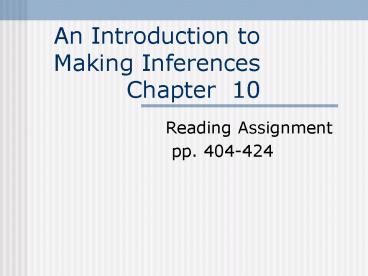An Introduction to Making Inferences Chapter 10 PowerPoint PPT Presentation
Title: An Introduction to Making Inferences Chapter 10
1
An Introduction to Making Inferences Chapter 10
- Reading Assignment
- pp. 404-424
2
Inferential Statistics
- Inferential Statistics Utilizes sample data to
make estimates, decisions, predictions or other
generalizations about the larger set of
data(i.e., infer), i.e., numbers that help to
assess the likelihood that randomly drawn samples
will display patterns that reflect the patterns
in the larger population
3
Terminology 3
- Recall
- Population a set of elements--usually people,
objects, transactions or eventsabout which
information is desired. - Sample a smaller, more manageable set of
elementsa subset of a populationselected to
represent the population for which it is drawn - Mean is the most stable of the three measures,
i.e., if several random samples are taken from
the same data set, there will be less variability
among the means than among the medians or modes.
4
Sampling 4
- Question How likely is it that the sample
selected is representative of the population? - Probability Sample a sample selected in such a
way that each element in the population has the
same chance of being drawn into the sample as
every other element in the population - Before drawing samples, come up with sampling
frame, or a list of elements in the population - P. 407random is not necessarily representative
5
Normal Distribution and z-score 5
- When the shape of the histogram of the
distribution is perfectly bell-shaped (unimodal
and symmetricalsingle mode and as many cases
above the mean as below) - Skills 1, p. 408
- Z-score an expression of the relationship
between a particular value in a distribution and
the mean in units of the standard deviation - Formula Z(X_i-mean)/(s) (sstd dev)
- Example, p. 409
- Interpretation, p. 410 Skills 2, p. 410
6
Z-score 5
- Reading TablesAppendix A
- Skills 3, p. 410
- Z scores in SPSSfollow pp. 411-12
- Skills 4, p. 414
- JTS 22 years educ (full-time)
- Excelstats z
7
Sampling Statistics 4
- Sampling statistic any statistic that describes
the distribution of values for a variable, or the
relationships between variables, in a sample - Eg./ Z scores, measures of central tendency,
measures of dispersion, and measures of
association - Sampling distribution the distribution of all
possible samples of a given size from a
particular population - P. 41520 people in class p. 416table 10.2
8
Sampling Distribution of sample means
4
- Hypothetical distribution of all possible sample
means of a given sample size from a particular
population - Formula 10.2 p. 417 example Skills 5
- Standard deviation of the sample means tells if
homogeneous or heterogeneous - Example p.418 Skills 6
9
Z scores for a population 7
- Formula 10.4
- Example, p. 420
- Skills 7 (computations for variables on p. 417)
- Std dev of sampling distribution of sample
meansalso called the standard error of the mean - Formula 10.5 example
- Avoiding pitfalls, p. 422
- Skills 8
- Hypothetical distribution of all possible sample
means of a given sample size from a particular
population - Formula 10.2 p. 417 example Skills 5
- Standard deviation of the sample means tells if
homogeneous or heterogeneous - Example p.418 Skills 6
10
Central Limit Theorem 2
- Note that the sampling distribution of the sample
mean is approximately normal for large sample
sizes - CLT If a random sample of n observations is
selected from a population (any population), then
when n is sufficiently large, the sampling
distribution of the sample mean will be a normal
distribution. The larger the sample size, the
better will be the normal approximation to the
sample distribution of the sample mean.
11
Central Limit Theorem--consequences 2
- Computing the mean and median for all possible
samples in a sampling distribution - The mean and the median for the sampling
distribution of sample means should be identical
(to the properties of a normal distribution) or
fairly close to it - There should be only one mode
- The distribution of the means should be
symmetrical - CLT demo
- http//sciris.shu.edu/mathlets/Math/Statistics/CLT
/clt.html
12
Homework
- P.429/14,15,18,19,20
- Spss/ 1
- Hand in gen ex 13, SPSS 3

